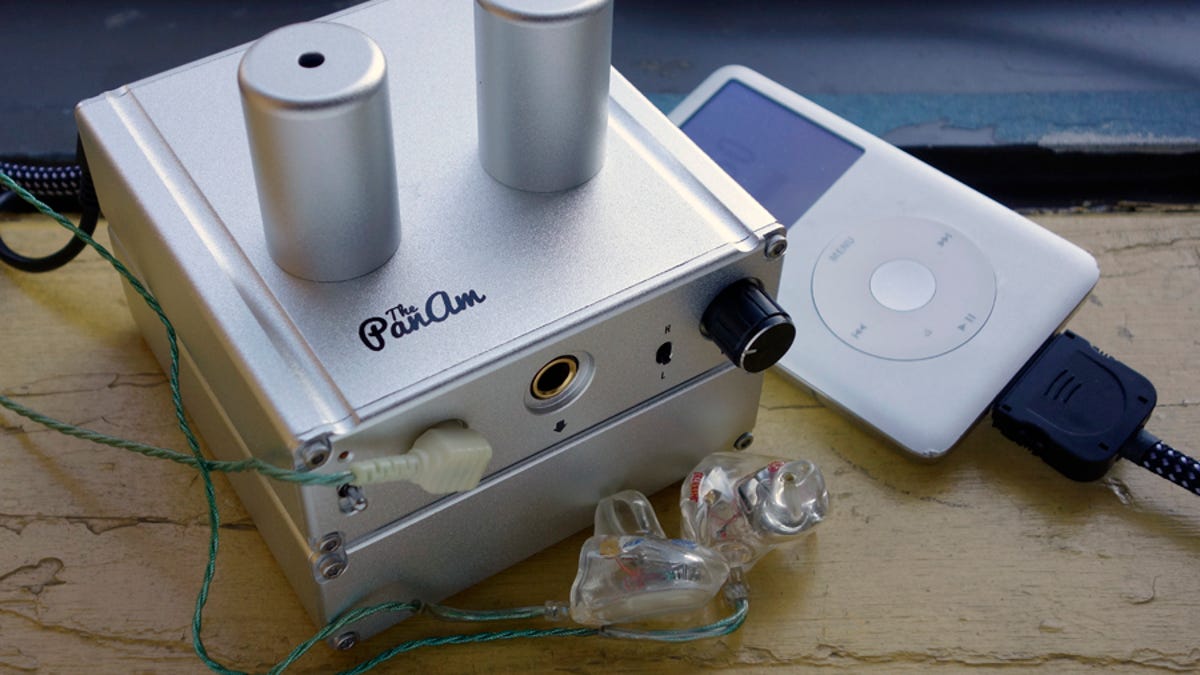Giant killer: ALO's tiny Pan Am headphone amplifier
The amp's diminutive size is a big plus; the Pan Am can fit on even the most cramped desktop.

Frankly, I was a little disappointed when I first unboxed the new ALO Pan Am tube headphone amp. It looked so cute and tiny; how could it possibly deliver the goods? The dainty 4.6-inch-by-3.8-inch footprint makes it easy to place anywhere. The amp's rear end houses three inputs: stereo RCA and 3.5mm analog inputs and a USB connection. The built-in digital-to-analog converter accommodates up to 24-bit/96-kHz audio. The amp is available in anodized silver or black finishes.
I started listening with my trusty Grado RS-1 headphones and loved the clarity. The Pan Am has the immediacy that makes music sound live, like it's being performed as I'm listening. That's the ultimate goal of great hi-fi, and I've had this feeling at recording sessions, when the music really is live, but achieving that after the fact is a rare occurrence. Match the Pan Am with a set of Sennheiser HD 700 headphones and you're there.
A lot of very good-sounding hi-fi gear sounds detailed and clear, but lacks the body and richness of the real thing. Next time you hear live, unamplified music, close your eyes and really focus on the sound. You'll hear not just the sound of the instruments in a real space, you'll get a sense of how each one radiates sound within that space. That's what the Pan Am lets you hear with great recordings, but it can't magically make the heavily compressed ones sound any better than they really are. I also tried the Pan Am with Bowers & Wilkins P5 on-ear headphones, and the sound was much clearer and more transparent than what I get from my iPod's headphone jack.
The Pan Am's vacuum tubes supply the initial amplification stages; transistors handle the output. The standard tubes sound great, but you can change the sound a little by swapping out the tubes. That's one of the nice things about tube gear: when you want a "new" sound, pop in a new set of tubes. Tube lifespans vary, but 5,000 hours per set should be doable. Tubes are available from ALO and a billion other places on the Web.
The front panel has a volume control, two headphone outputs -- 3.5mm and 6.3mm -- and a high/low gain switch. In-ear and full-size headphones designed for portable use shine with the low-gain position; home models are better with the high-gain setting. The Pan Am is remarkably quiet for a tube amp, so it didn't add noise or hiss to the sound, even when I listened with my Jerry Harvey JH-13 in-ear headphones.
When I had started listening with my computer I was using the AudioQuest Dragonfly USB digital-to-analog converter feeding the Pan Am's analog input. The sound was wonderful, but when I switched over to the amp's internal DAC, the sound was significantly more transparent and pure. That surprised me; the Dragonfly is exceptional, so it's nice to know there's no need to spring for a separate DAC with the Pan Am. Spurred on, I plugged in my hard-to-drive Hifiman HE-500 planar magnetic headphones, and the Pan Am obliged again, and delivered even better sound.
Upgrading from the Pan Am's standard wall-wart power supply to the optional $149 Gateway supply fleshes out the sound. Everything I like about the Pan Am gets better. The optional $199 PassPort lithium polymer battery power supply runs for a maximum of 10 hours, and I preferred the battery supply's warmer sound. The PassPort makes the Pan Am semiportable; the two boxes are too big to play as you walk around or to stuff in a backpack, but you could easily take the amp on vacation or to work. You can start with the basic Pan Am and add either or both supplies at a later date. If you don't think they make a worthwhile difference, you have 30 days to return them and get your money back.
I have a few complaints: the Pan Am and power supplies are so small and light they don't stay put on my desktop. I'd consider using Velcro to attach them to each other and to the desktop to stop them from sliding around. The input selector is on the rear panel, so sure, you can reach around, but the selector really should be up front.
ALO sells all types of cables, including one to hook up to any iDevice with a 30-pin connector to the amp. That connector bypasses the phone or iPod's internal volume control/headphone amp and produces better sound than the headphone jack.
I don't recommend buying the Pan Am or any high-performance amp if you don't already own at least one pair of really great headphones. The basic Pan Am is $599, and for that kind of money you can get a terrific set of headphones, and when you're ready to tap their full potential, the Pan Am will be a revelation. If you already have killer 'phones, but you're just plugging them directly into your computer or phone, you don't know how great they can sound.
ALO sells these products direct with a 30-day return policy. Discounts are offered when you buy more than one part of the system at a time. Try 'em; you'll like 'em.

